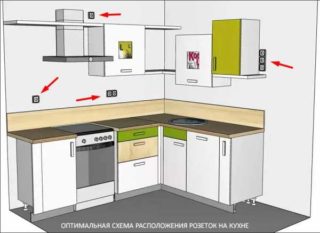A large number of electrical appliances are concentrated in the kitchen, for which the connection point should be thought out. When installing, you also need to pay attention to the layout. Corner sockets for the kitchen are appropriate in large and small spaces, they are compact and convenient for self-assembly.
- Features of corner sockets
- Advantages and disadvantages
- Rules for placing sockets in the kitchen
- How many sockets are needed
- How to arrange
- What to look for when choosing
- Manufacturing material
- Rated current of the socket
- Availability of grounding
- Method of fixing wires in terminals
- Availability of protection
- The presence or absence of the ejection mechanism
- Standards for mounting sockets
- Choosing the location of the sockets
Features of corner sockets
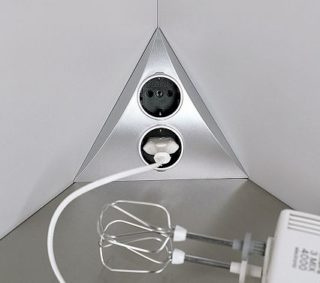
Angle type sockets are available in a robust plastic case. Double, single, combined modules are suitable for positioning between the worktop and the wall, under the cupboards, at the joints. The products look elegant and do not take up much space.
Device design:
- base made of plastic or ceramic with fasteners in the form of paws or ears;
- front panel - matched by color;
- current-carrying elements - terminals (self-regulating or screw), grounding contacts.
The socket is intended for integration with hidden or exposed wiring. In the first case, it is placed in a strobe, in the second - in a socket box.
Advantages and disadvantages
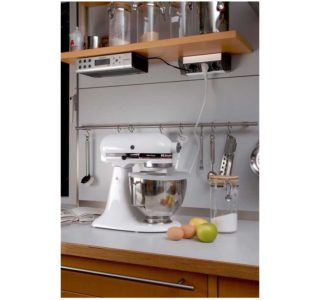
The advantages of corner devices include:
- elegant appearance;
- saving space in the kitchen;
- the presence of several modules for ease of use;
- compliance with European standards and Russian GOST;
- good dust and moisture protection;
- equipping with timer, wattmeter, backlight.
There are some disadvantages when operating and installing sockets in the corner:
- with poor-quality fastening to drywall, they can come off;
- high power - not always suitable for Soviet-style houses;
- connecting no more than two devices - the plugs of the rest will interfere;
- impossibility of using for powering lighting.
Despite a number of disadvantages, corner-type electrical fittings are a functional and safe solution for the kitchen.
Rules for placing sockets in the kitchen
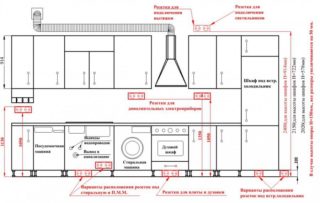
When planning to place corner kitchen sockets, be guided by building codes:
- the socket is removed from the side of the equipment by 15-20 cm;
- the distance from the device to the device built into the headset is no more than 1 m;
- installation near the sink of products with moisture protection from IP44;
- removal of the block from the hood by 20-30 cm;
- connecting an electric stove, washing machine, oven, refrigerator, PMM to separate power sources;
- the total power of electrical appliances should not exceed the permissible power for the power line;
- power sockets are of two types - 10 A (2.2 kW) and 16 A (3.5 kW).
Products adjacent to the pipe should be fitted with caps and rubber bands to protect against pipe breaks.
How many sockets are needed
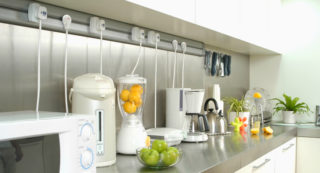
The number of outlets should be planned at the design stage of the space. In the classical scheme, the number of connection points is equipped, equal to the number of household appliances. This is not entirely true:
- portable gadgets are used indoors - a vacuum cleaner, a laptop, a mobile phone;
- users purchase additional equipment for which there will be no room;
- there is a need to use an extension cord.
To avoid inconvenience, you need to add another 25% to the existing devices. When calculating, take into account stationary equipment, temporary devices. The best option would be:
- 2-3 devices near the apron;
- 1 - in the countertop or near the eating area;
- 1 - next to the entrance.
Using a corner stationary unit with the required number of outlets, you can solve the problem of organizing space for the kitchen.
How to arrange
- Upper - hood, TV, furniture lighting. The location of the outlet at a height of 5-10 cm from the edge of the upper cabinet will be optimal.
- Medium - low power devices. For ease of access, the socket boxes are placed 20-10 cm above the countertop, and 60 cm removed from the edges of the stove and sink.
- Bottom - here you can build in kitchen appliances, placing sockets at a height of 30-60 cm from the floor only in cupboards or in the niches of the rear walls of the pedestals.
Installation behind a stove or dishwasher excludes direct access to the units.
What to look for when choosing
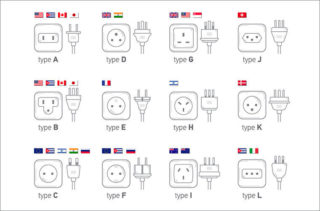
Before buying corner outlets, you should pay attention to several parameters:
- Mounting type - can be built into the headset or placed "in one frame" on the wall surface.
- Power - 16 A models are suitable for old apartments, 25-32 A devices are justified in houses.
- Plug type - European C-type sockets are used on the territory of the Russian Federation. Their contacts are removed from the center by 10 mm.
- Protection - for the kitchen, it is worth choosing devices with moisture protection from IP44 to IP55.
- Conditions of Use - NEMA2 marking permits installation of products in rooms with low levels of humidity and dust.
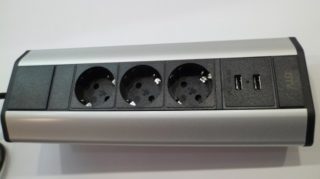
Manufacturers equip sockets with additional functions:
- child protection - sliding plug holes;
- timer - interruption of the current supply after a certain time;
- wattmeter - the consumed voltage is shown;
- indicator - a change in shade depending on the power;
- combination with a switch is an economical and energy efficient option;
- backlight - convenient for the cooking area;
- USB connector - for charging gadgets.
Portable products are most often double and triple.
Manufacturing material
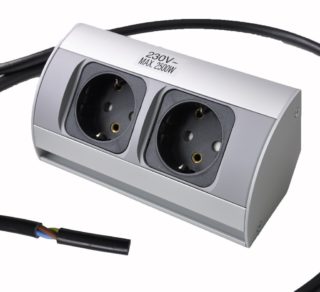
Several types of dielectric materials are used for the manufacture of the housing of the angular socket blocks.
- Ceramics. The housing can withstand high temperatures due to overheating of the cell contacts. The planting nest can be one or several. Holes for fasteners and threaded niches for the plastic cover are provided. The disadvantage of the material is fragility, when pressed, the electrical accessories may break.
- Plastic. The outer casing is made of non-flammable plastic and is a dielectric. The base retains its strength when exposed to temperatures, does not burn, and has good moisture protection. Cons - flammability of budget models made of polystyrene.
When assembling a structure without a junction box, it is better to stop at plastic outlets.
Rated current of the socket
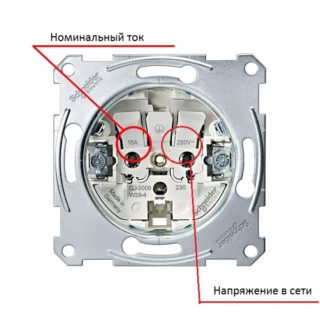
GOST R 51322.1-2011 establishes a limitation on the rated current of models with screwless fastening up to 16 A. The maximum for a Soviet outlet is 6 A. A number of manufacturers produce devices that can withstand 25 A, but they are extremely rare. It is recommended to install power sockets under the hob or electric stove that can withstand up to 32 A.
The maximum power of the connected equipment depends on the number of amperes and is presented in the table.
| The current in the outlet | Power of technology |
| 6 A | 1.3kw |
| 10 A | 2.2 kW |
| 16 A | 3.5 kW |
| 32 A | 7 kW |
Standard household appliances connected to a 220 V network have a total power of up to 3.5 kW.
Availability of grounding
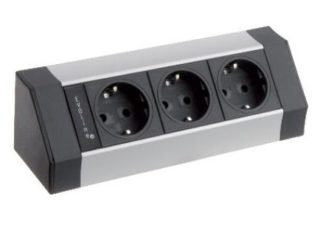
For the kitchen, only an earthed corner socket strip is suitable.The presence of "earth" can be determined by the antennae opposite each other on the body. They are located next to the side fork holes.
The antennae are connected to the grounding system and are additionally protected by plates, which, in contact with the mating elements of the plug, ground the device. When connected, the antennae are thrown to the ground - on the right is zero, on the left is the phase.
Method of fixing wires in terminals
Sockets with grounding are connected to a three-wire yellow-green cable. The instrument already has a ground terminal marked with the appropriate marker. Corner versions are equipped with the same earthing terminals, a loop or parallel connection is located in the block. The wiring in the terminals is fixed like this:
- adjacent elements - parallel connection by cables of input and output to the socket;
- with the removal of the insulating layer - 10 mm of the top layer is cut off, a ring is made and tightened with an engraving screw until the first device is connected, the wire is cut off after the last element is installed.
For any method of fixing, calculate the wire size.
Availability of protection
The kitchen block of corner outlets is marked according to the degree of protection.
From getting inside solid objects is indicated by numbers:
- 1 - parts 0-50 mm in diameter can penetrate;
- 2 - objects 12.5 mm in diameter do not fall;
- 3 - small objects up to 2.5 mm in diameter do not penetrate into the body;
- 4 - objects with a diameter of more than 1 mm do not fall.
Dust protection is indicated by 5 (dustproof) and 6 (dustproof).
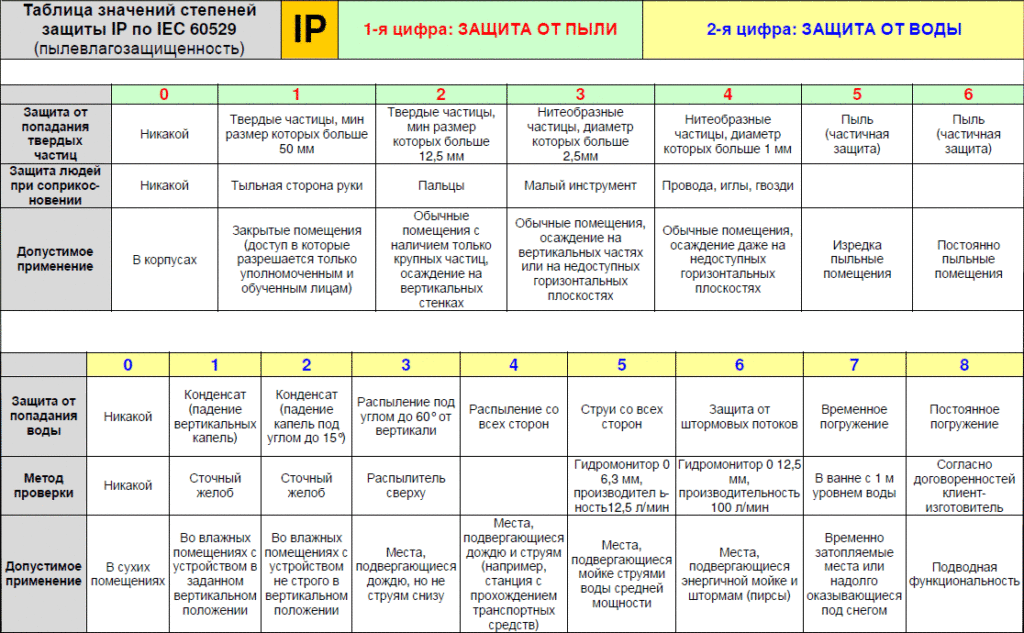
The letter H denotes compatibility with high-voltage devices, M - the ability to work with water jets, S - no work with moving particles of water. Sockets with index W are weatherproof.
Touch protection is also indicated by letters: A - with the back of the hand, B - with fingers, C - with a power tool, D - with a wire.
Digital marking means that they do not interfere with the operation of the product:
- 1 - vertical drops;
- 2 - drops at an angle of 15 degrees;
- 3 - splashes falling at angles of 60 degrees;
- 4 - drops in any direction;
- 5 - water jet in any direction;
- 6 - sea water jets.
Products with moisture protection 5 and 6 are intended for outdoor installation.
The presence or absence of the ejection mechanism
In the absence of a push-out mechanism, the sockets will loosen and interfere with the normal operation of the equipment. In the presence of a push-out, the user simply presses a button and the plug is automatically removed from the socket. The extraction force is 9-54 N.
If, when the ejection mechanism is broken, the plug is stuck in the device, it can only be removed with two hands.
Standards for mounting sockets
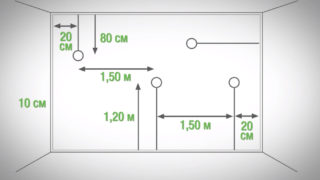
During installation, follow the rules specified in GOST 7396.1-89, 7397.0-89, 8594-80 and SNiPe 3.05.06-85:
- according to European standards, the outlet groups must be installed at a height of 30 cm from the floor;
- in large rooms, remove products 50 cm from heating, water pipes and sinks;
- when planning to build the outlet into the panel, select only the factory box;
- grounding of all electrical connection points and installation of an RCD are mandatory measures;
- sockets for powerful consumers are placed behind them - for the refrigerator 60-80 cm from the floor line, for the washing machine - 30 cm;
- constantly working equipment can be connected to group corner devices;
- the optimal number of socket outlets is 3;
- the corner device is placed 10-20 cm above the table top;
- sockets for the hood are equipped at a height of 1.8-2 m and are powered from furniture lighting.
To keep the corner socket out of sight, use the overhead mounting method behind the cabinet sash.
Choosing the location of the sockets
The selection of the location is carried out before the start of the organization of the grounding line. Most often, the device is installed at a distance of 30 cm from the baseboards or is guided by vertical zoning.
To preserve the finish, the sockets are placed near the plinth and then the cable line is run.For a medium-sized kitchen, 3-4 sockets with easy access are sufficient. The socket is placed externally (above the surface) or internally (recessed).
Installing a socket during repair will prevent dust and dirt from entering the inside of the case.
Corner outlet groups will ensure the safe operation of electrical appliances. Competently arranging them, you can get a harmonious and functional design.

